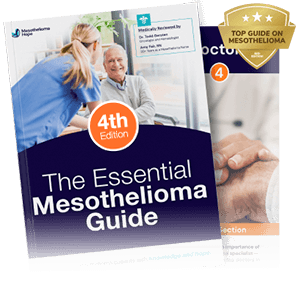What Is Stage 3 Mesothelioma?
As the second-to-last stage of mesothelioma, stage 3 mesothelioma generally refers to cancer that has spread deeper into the tissues surrounding the tumor’s original location and has usually reached the lymph nodes.
Depending on the type, mesothelioma may begin in the:
- Pleura: Lining of the lungs and chest
- Peritoneum: Lining of the abdomen
- Pericardium: Lining of the heart
- Tunica vaginalis: Membrane lining the testes
A stage 3 diagnosis may also reveal that the cancer has spread to the nearby lymph nodes. Mesothelioma that spreads to more distant sites, like the collarbone or lymph nodes on the other side of the chest, is considered stage 4.
Stage 3 mesothelioma is the second of the advanced mesothelioma stages outlined under the tumor-node-metastasis (TNM) staging system, which is the U.S. standard for measuring how far most types of cancer have progressed.
- Approximately 16% of mesothelioma cases are diagnosed during the regional stage, which roughly corresponds to stage 3.
- About 12% of pleural mesothelioma patients diagnosed during the regional stage (which includes stage 3) will live 5 years or longer.
- During stage 3, mesothelioma has spread too far for most patients to undergo surgery.
- Stage 3 mesothelioma patients are usually excellent candidates for clinical trials testing new cancer therapies.
Because stage 3 mesothelioma hasn’t yet spread to the other side of the chest, it is still considered somewhat local even though it has slightly spread.
Pleural mesothelioma is the only type of mesothelioma with an official staging system. Several staging systems had been proposed for peritoneal mesothelioma, but none have been officially accepted. Peritoneal mesothelioma is still sometimes referred to in stages, however.
Not enough is known about pericardial mesothelioma and testicular mesothelioma to properly stage them. Instead, doctors may refer to pericardial and testicular mesothelioma stages as early or advanced.
Learn more about the different types and stages of this cancer — and the most effective treatments — in our Free Mesothelioma Guide.
How Stage 3 Mesothelioma Develops
The Centers for Disease Control and Prevention (CDC) states that mesothelioma may take anywhere from 10-50 years to develop after asbestos exposure. However, the disease progresses rapidly once symptoms appear.
As cancer cells multiply, they cause tumors to grow and spread. Eventually, these cells may travel through the lymph nodes and form new tumors in distant parts of the body. This process is called mesothelioma metastasis, and doctors try to prevent or control it through treatment.
While stage 3 mesothelioma has not metastasized, it has spread deeper into nearby tissues and reached the lymph nodes.
The TNM system divides stage 3 mesothelioma into two sub-sections depending on severity: 3A and 3B.
Stage 3 Mesothelioma TNM System Subtypes
| Subtype | Tumor | Lymph Node | Metastasis |
|---|---|---|---|
| 3A | The tumor is in the pleura on one side of the chest, the diaphragm, and the space between the lungs. It has also grown into other areas such as at least one layer of the chest wall. | The cancer has spread to nearby lymph nodes on the same side of the body as the main tumor. | The cancer has not spread to distant parts of the body yet. |
| 3B | The cancer may have grown into nearby parts of the body. It has also grown into at least one more distant area, such as deeper layers of the chest wall, the lining of the abdomen, or the spine. | The cancer may have spread to lymph nodes on the other side of the body. | The cancer has not spread to distant parts of the body. |
As mesothelioma progresses from stage 2 to stage 3, most patients experience common mesothelioma symptoms.
Stage 3 Mesothelioma Symptoms
While early-stage mesothelioma is typically asymptomatic (showing no signs or symptoms), as the cancer spreads and tumors grow, stage 3 mesothelioma patients usually notice significant symptoms.
Common mesothelioma stage 3 symptoms include:
- Abdominal pain
- Chronic fatigue
- Difficulty breathing
- Fatigue
- Fever
- Noticeable weight loss
- Sweating
- Worsened chest pain
This is when most mesothelioma victims go to their doctor and begin the process of identifying the source of their symptoms. However, even though by stage 3 the symptoms have worsened, they can still be confused with symptoms of pulmonary infections such as pneumonia or bronchitis.
You should discuss your symptoms as soon as possible with a doctor to prevent a misdiagnosis. This can help you start to receive life-saving treatment sooner.
How to Identify Stage 3 Mesothelioma
At stage 3, mesothelioma is easier to identify. However, doctors may still initially confuse stage 3 mesothelioma symptoms for other conditions like viral pneumonia.
By reading the results of a chest X-ray or other imaging tests, doctors can identify abnormalities such as tumors, fluid buildup, and thickening of the lining of the lungs.
While these symptoms are strong indicators of mesothelioma, they may also be signs of other cancers and conditions. Asbestos is the main cause of mesothelioma, so it is critical for patients to tell their doctors about any history of asbestos exposure.
Download our Free Questions to Ask Your Doctor Checklist before your appointment to ensure you get the answers you need.
Stage 3 Mesothelioma Diagnosis
Because symptoms are far more prominent during stage 3, most patients are diagnosed with mesothelioma during this stage.

When diagnosing mesothelioma, doctors may initially take computerized (CT) images of the patient’s chest from multiple angles to identify the location of any tumors. However, a mesothelioma diagnosis cannot be confirmed without a biopsy.
During a biopsy, a tissue sample is removed from the tumor or surrounding fluid. By examining this sample under a microscope, a doctor can see if any of its cells are cancer cells.
Stage 3 Diagnosis and Staging Systems
Upon diagnosis, doctors use a staging system to find out how far a patient’s mesothelioma has advanced and what the outlook for their disease is.
The TNM staging system is the most widely accepted staging system for pleural mesothelioma, although other systems exist.
Pleural mesothelioma is the only type officially staged under any of these systems, which all have their own way of describing stage 3.
Stage 3 Pleural Mesothelioma By Staging System
- Brigham system: Cancer has spread to the chest wall, heart, diaphragm, or abdominal cavity. The cancer may have reached the lymph nodes. Stage 3 tumors are not surgically removable.
- Butchart system: The cancer has spread past the pleura and the chest wall, to the diaphragm, the lining of the abdomen, or both.
- TNM system: The cancer has spread past the pleura into the deeper tissues and may have reached areas such as the abdominal lining or spine. Cancer may have spread to both sides of the body. It has spread to the lymph nodes but has not reached distant parts of the body.
Many medical communities worldwide use the TNM staging system for its practicality in terms of understanding a patient’s prognosis.
Stage 3 Mesothelioma Prognosis
Because treatment options in stage 3 are limited, the prognosis is considered poo but may be improved with treatment. A prognosis describes how a disease is expected to progress.
In stage 3, it’s important to consider getting a second opinion from a mesothelioma specialist. A specialist can confirm your diagnosis or provide you with new information about your disease that other doctors may have missed. Oftentimes, a second opinion can present you with other treatment options that you otherwise wouldn’t have known about.
Doctors determine a patient’s mesothelioma prognosis using the stage of the patient’s disease at diagnosis along with other factors such as mesothelioma cell type and the patient’s age, gender, and overall health.
Stage 3 Mesothelioma Life Expectancy
Mesothelioma life expectancy is the average amount of time doctors expect a patient to live after diagnosis. For mesothelioma, life expectancy is usually measured in months.
The average mesothelioma stage 3 life expectancy is 16 months.
Stage 3 Mesothelioma Survival Rate
The percentage of people with mesothelioma who survive for a certain amount of time (often measured in 1-, 3-, and 5-year increments after diagnosis) is known as the mesothelioma survival rate.
A 2017 study published in Lung Cancer International collected data from more than 11,000 pleural and peritoneal mesothelioma patients between 1973–2011 to show how a person’s stage at diagnosis affects survival rates.
The study described pleural and peritoneal mesothelioma stages as:
- Localized: Stage 1 mesothelioma contained in one area
- Regional: Stage 2, 3, and 4 mesothelioma that has not spread to distant body parts
- Distant: Stage 4 mesothelioma that has spread to parts of the body far from where it originated
The tables below show the percentage of mesothelioma patients out of the entire study who lived for at least 1 year or 5 years, respectively, after diagnosis.
Survival Rates for Pleural Mesothelioma by Stage
| Mesothelioma Stage | 1-Year Survival Rate | 5-Year Survival Rate |
|---|---|---|
| Localized | 41% | 6% |
| Regional | 40% | 4% |
| Distant | 32% | 3% |
Survival Rates for Peritoneal Mesothelioma by Stage
| Mesothelioma Stage | 1-Year Survival Rate | 5-Year Survival Rate |
|---|---|---|
| Localized | 74% | 26% |
| Regional | 55% | 19% |
| Distant | 40% | 11% |
A patient’s remaining life expectancy may be greatly influenced by the stage of their mesothelioma after diagnosis. Stage 3 mesothelioma tumors are usually not resectable (surgically removable), which prevents patients from undergoing the most effective treatment options for increasing their life expectancy.
However, even stage 3 patients who cannot receive surgery may benefit from chemotherapy and other treatments. Use our Free Doctor Match to connect with a specialist who can help you explore the right treatments for your diagnosis.
Stage 3 Mesothelioma Treatment
Although stage 3 mesothelioma is considered an advanced stage, there are still treatment options for patients. Typically, the goal with stage 3 treatments is to improve quality of life. This is done through palliative therapies that relieve pain.

Stage 3 malignant mesothelioma treatment may involve surgery, chemotherapy, radiation, or new treatments being tested in clinical trials. The optimal treatment approach for stage 3 patients whose mesothelioma has not spread too far to be surgically removed is a combination of surgery, chemotherapy, and radiation therapy.
Patients who cannot undergo surgery often receive chemotherapy alone.
Stage 3 Mesothelioma Surgery
Depending on the patient’s overall health, mesothelioma surgery may still be an option.
If you are eligible, surgeries in stage 3 can also be supplemented with chemotherapy and radiation to shrink tumors and kill remaining cancer cells. This multimodal therapy plan can improve your life expectancy by several months or even years in some cases.
Stage 3 mesothelioma is often not able to be operated on because the tumor has spread too far for surgeons to effectively remove it. However, some stage 3 tumors may be able to be surgically removed so that no visible parts of the tumors remain.
Doctors may consider the following factors to decide if a patient can undergo surgery:
- Cell type: Only epithelioid and mixed/biphasic cell tumors are resectable.
- Stage: Small, localized tumors are easier to surgically remove.
- Location: If a tumor is too close to a vital organ, it may be too dangerous to surgically remove it.
- Patient health: Mesothelioma surgery can be risky and taxing on a patient’s body. Doctors will carefully consider a patient’s health to decide how likely they are to survive or properly recover from an operation.
If a patient is a good surgery candidate, they have a few options depending on their type of stage 3 mesothelioma and their doctor’s recommendations.
Stage 3 mesothelioma surgery options may include:
- Extrapleural pneumonectomy (EPP) for pleural mesothelioma
- Pleurectomy with decortication (P/D) for pleural mesothelioma
- Cytoreduction with HIPEC for peritoneal mesothelioma
After surgery, some cancer cells remain. For this reason, doctors usually treat patients with chemotherapy and/or radiation to destroy remaining cells.
Stage 3 Mesothelioma Chemotherapy
Mesothelioma chemotherapy involves the intravenous administration of drugs that destroy cancer cells. It is a popular standalone treatment option for stage 3 mesothelioma patients.
Doctors may use chemotherapy on stage 3 mesothelioma patients to:
- Destroy cancer cells doctors cannot surgically remove
- Stop cancer cells from spreading before, during, or after surgery
- Treat patients who cannot undergo surgery
While mesothelioma chemotherapy and surgery may be an effective treatment combination for some stage 3 mesothelioma patients, a three-pronged treatment approach of surgery, chemotherapy, and radiation may lead to the best results for both pleural and peritoneal mesothelioma patients.
Stage 3 Radiation Therapy
During radiation therapy, doctors use high-energy rays to target the DNA of cancer cells and destroy them. For stage 3 mesothelioma patients able to undergo surgery, radiation may be used as part of a multimodal treatment approach.
Radiation therapy may also be used with chemotherapy for many stage 3 patients. This combination may increase each therapy’s effectiveness at destroying cancer cells in the original tumor site and cells that may have spread to other parts of the body.
Radiation therapy may help treat stage 3 mesothelioma by:
- Killing cells that remain after surgery
- Making surgery easier by shrinking tumors beforehand
- Slowing the return of cancer after surgery
While a three-treatment approach may be the most helpful option for stage 3 mesothelioma patients who can undergo surgery, other treatment options are available for the many who are not able to receive standard treatment.
Our caring Patient Advocates can help you navigate treatment options, as well as all other aspects of a mesothelioma diagnosis.
Other Treatment Options for Stage 3 Mesothelioma
Another option in stage 3 is clinical trials. Clinical trials provide emerging treatments that can improve your life expectancy. Be sure to ask your health care team if you qualify for mesothelioma clinical trials.
Emerging mesothelioma treatments may include:
- Anti-angiogenesis
- Gene therapy
- Immunotherapy
- Photodynamic therapy
Patients should keep the stage of their mesothelioma in mind when searching for clinical trials since many restrict patients by cancer stage.
Learn more about mesothelioma clinical trials and emerging treatments in our Free Mesothelioma Guide.
Improving Your Stage 3 Mesothelioma Prognosis
Many factors that determine a patient’s stage 3 mesothelioma prognosis are out of the patient’s control. However, patients can still take action to improve their prognosis as much as possible.
The following actions may improve a stage 3 mesothelioma prognosis:
- Eating well: Nutrition is essential for a strong immune system and a quick and complete recovery after invasive treatments like surgery and chemotherapy.
- Exercising: Exercise has several health benefits, including lowering stress, improving blood flow, and helping prevent secondary health issues like bedsores.
- Managing stress: Stress can negatively affect health by increasing blood pressure, causing sleep problems, and other issues. This may slow treatment recovery and decrease quality of life.
- Not smoking: Smoking negatively affects overall patient health and may even disqualify a patient from certain treatments. It may also increase the chance of another cancer diagnosis, such as lung cancer.
- Seeking life-extending treatment: For many mesothelioma patients, life-extending treatments are simply not an option because their cancer is already too advanced. However, some stage 3 patients are still good candidates for such treatments.
As new treatment methods continue to develop, mesothelioma patients at all stages can look forward to longer survival rates — and one day, perhaps, a cure.
Find Treatment for Stage 3 Mesothelioma
At any stage of mesothelioma, treatment may be able to lessen your symptoms and help you live more comfortably. However, it’s important to find a qualified mesothelioma doctor who can determine the most effective treatment methods to improve your prognosis.
Have you or a loved one been diagnosed with stage 3 mesothelioma? Get connected with top mesothelioma specialists near you for free.
Stage 3 Mesothelioma FAQs
Can you survive stage 3 mesothelioma?
The average life expectancy of stage 3 mesothelioma is 16 months. However, some patients have lived much longer than this.
The most effective way to live longer is through mesothelioma treatment, which may include chemotherapy, radiation therapy, surgery, and/or participation in clinical trials.







